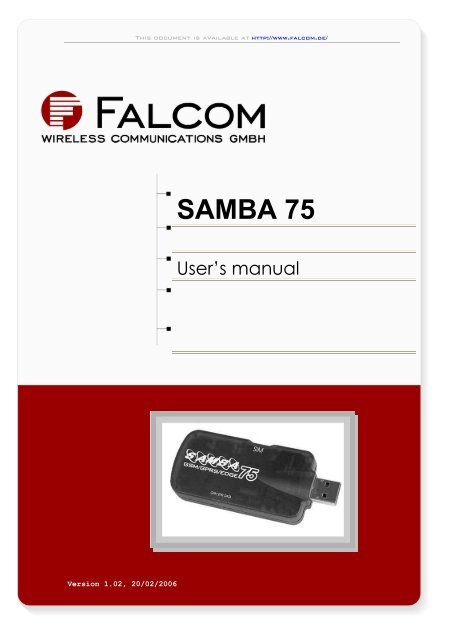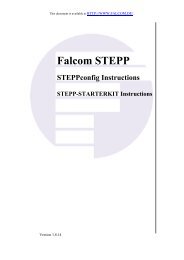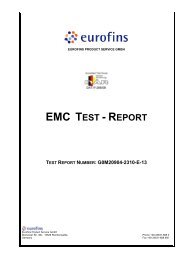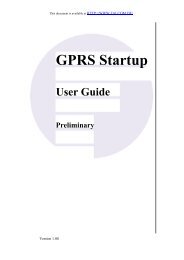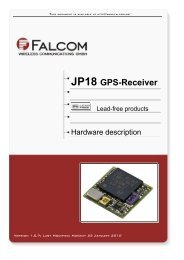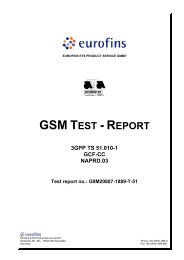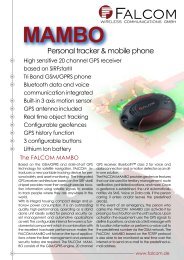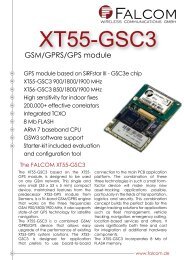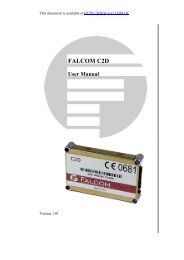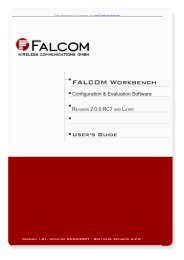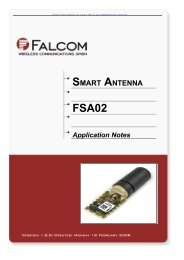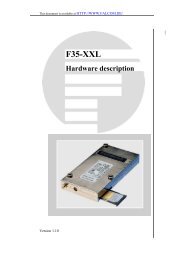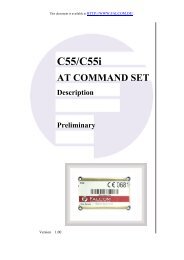Create successful ePaper yourself
Turn your PDF publications into a flip-book with our unique Google optimized e-Paper software.
Version 1.02, 20/02/2006<br />
This document is available at HTTP://WWW.FALCOM.DE/<br />
SAMBA <strong>75</strong><br />
User’s manual
SAMBA <strong>75</strong> USER’S GUIDE VERSION 1.02<br />
Index of contents<br />
0 INTRODUCTION .........................................................................5<br />
0.1 GENERAL ................................................................................................................................5<br />
0.2 SCOPE OF DELIVERY ................................................................................................................ 6<br />
0.3 USED ABBREVIATIONS .............................................................................................................. 6<br />
0.4 RELATED DOCUMENTS ............................................................................................................. 7<br />
1 SECURITY ..................................................................................8<br />
1.1 GENERAL INFORMATION ........................................................................................................... 8<br />
1.2 EXPOSURE TO RF ENERGY....................................................................................................... 8<br />
1.3 EFFICIENT MODEM OPERATION.................................................................................................. 8<br />
1.4 ANTENNA CARE AND REPLACEMENT .......................................................................................... 8<br />
1.5 DRIVING .................................................................................................................................. 9<br />
1.6 ELECTRONIC DEVICES .............................................................................................................. 9<br />
1.7 VEHICLE ELECTRONIC EQUIPMENT ............................................................................................ 9<br />
1.8 MEDICAL ELECTRONIC EQUIPMENT............................................................................................ 9<br />
1.9 AIRCRAFT................................................................................................................................9<br />
1.10 CHILDREN ............................................................................................................................... 9<br />
1.11 BLASTING AREAS ................................................................................................................... 10<br />
1.12 POTENTIALLY EXPLOSIVE ATMOSPHERES................................................................................. 10<br />
1.13 NON-IONIZING RADIATION ....................................................................................................... 10<br />
2 SAFETY STANDARDS.............................................................11<br />
3 TECHNICAL DATA...................................................................12<br />
3.1 GENERAL SPECIFICATIONS OF SAMBA <strong>75</strong> .............................................................................. 12<br />
3.1.1 Power consumption ............................................................................................................. 14<br />
4 INTERFACES IN OVERVIEW...................................................15<br />
4.1 INTERFACE A (4-PIN USB TYPE A CONNECTOR) ..................................................................... 15<br />
4.2 INTERFACE B (OPTICAL INTERFACE) ....................................................................................... 16<br />
4.3 INTERFACE C (SIM-CARD INTERFACE).................................................................................... 16<br />
4.4 FUNCTIONAL DESCRIPTION ..................................................................................................... 17<br />
5 GSM/GPRS APPLICATION INTERFACE ................................18<br />
5.1 DESCRIPTION OF OPERATING MODES ...................................................................................... 18<br />
5.1.1 Normal mode operation ....................................................................................................... 18<br />
5.1.1.1 GSM/GPRS SLEEP ........................................................................................................................ 18<br />
5.1.1.2 GSM IDLE....................................................................................................................................... 18<br />
5.1.1.3 GPRS/EDGE IDLE.......................................................................................................................... 18<br />
5.1.1.4 GPRS/EDGE DATA ....................................................................................................................... 18<br />
5.1.2 Power down......................................................................................................................... 18<br />
5.1.3 Alarm mode ......................................................................................................................... 19<br />
5.2 POWER UP / POWER DOWN SCENARIOS................................................................................. 19<br />
5.2.1 Turn on SAMBA <strong>75</strong>.............................................................................................................. 19<br />
5.2.1.1 Reset SAMBA <strong>75</strong> via AT+CFUN Command.................................................................................... 19<br />
5.2.2 Turn off SAMBA <strong>75</strong>.............................................................................................................. 19<br />
5.2.2.1 Turn off SAMBA <strong>75</strong> Using AT Command ........................................................................................ 19<br />
This confidential document is a property of FALCOM GmbH and may not be copied or circulated without previous permission.<br />
Page 1
SAMBA <strong>75</strong> USER’S GUIDE VERSION 1.02<br />
5.2.3 Automatic Shutdown............................................................................................................ 20<br />
5.3 AUTOMATIC EGPRS/GPRS MULTISLOT CLASS CHANGE ........................................................ 20<br />
6 SYSTEM REQUIREMENTS......................................................21<br />
6.1 HARDWARE & SOFTWARE REQUIREMENTS............................................................................... 21<br />
6.2 GET STARTED ........................................................................................................................ 21<br />
6.2.1 Installing your SAMBA <strong>75</strong> on a Laptop computer running Windows® XP .......................... 21<br />
6.2.1.1 How to use SAMBA <strong>75</strong> phone with a terminal software, only.......................................................... 22<br />
6.2.1.2 Setup HyperTerminal program:....................................................................................................... 24<br />
6.2.1.3 Making a dial-up networking............................................................................................................ 25<br />
6.2.2 Communications software ................................................................................................... 25<br />
6.2.3 PIN & PUK........................................................................................................................... 25<br />
6.2.4 Text messages .................................................................................................................... 25<br />
6.2.5 Data and fax communication............................................................................................... 26<br />
7 RF EXPOSURES ......................................................................27<br />
8 APPENDIX ................................................................................28<br />
8.1 TROUBLESHOOTING ............................................................................................................... 28<br />
This confidential document is a property of FALCOM GmbH and may not be copied or circulated without previous permission.<br />
Page 2
SAMBA <strong>75</strong> USER’S GUIDE VERSION 1.02<br />
Version history:<br />
Version number Author Changes Release date<br />
1.00 Fadil Beqiri - Initial version 29/09/2005<br />
1.01 Fadil Beqiri<br />
1.02 Fadil Beqiri<br />
- Figure (Y-Cable) in chapter 0.2 on page 6 has been replaced by a<br />
new one.<br />
- Because the SAMBA<strong>75</strong> does not provide any audio interface, the<br />
ring tones item listed in chapter 3.1 on page 12 has been removed.<br />
- Figure 7.b has been added. It represents direct connection to a free<br />
USB port.<br />
- Chapter 7 on page 27 “RF Exposures” has been added.<br />
- Updated EDGE data transfer (achieving an average throughput of<br />
80 to 160 kbps supporting 2-4 timeslots. Our lab test results – see<br />
EDGE on page 13).<br />
20/02/2006<br />
20/02/2006<br />
This confidential document is a property of FALCOM GmbH and may not be copied or circulated without previous permission.<br />
Page 3
SAMBA <strong>75</strong> USER’S GUIDE VERSION 1.02<br />
Cautions<br />
Information furnished herein by FALCOM is accurate and reliable. However, no<br />
responsibility is assumed for its use.<br />
Please, read carefully the safety precautions.<br />
If you have any technical questions regarding this document or the product<br />
described in it, please contact your vendor.<br />
General information about FALCOM and its range of products are available at the<br />
following Internet address: http://www.falcom.de/<br />
Trademarks<br />
Some mentioned products are registered trademarks of their respective companies.<br />
Copyright<br />
SAMBA <strong>75</strong> user’s guide is copyrighted by FALCOM Wireless Communications GmbH<br />
with all rights reserved. No part of this user’s guide may be produced in any form<br />
without the prior written permission of FALCOM Wireless Communications GmbH.<br />
FALCOM Wireless Communications GmbH.<br />
No patent liability is assumed with respect to the use of the information contained<br />
herein.<br />
This confidential document is a property of FALCOM GmbH and may not be copied or circulated without previous permission.<br />
Page 4
SAMBA <strong>75</strong> USER’S GUIDE VERSION 1.02<br />
0 INTRODUCTION<br />
0.1 General<br />
This manual is focussed on the GSM/GPRS/EDGE data solutions of the enhanced<br />
performance SAMBA <strong>75</strong> USB modem from FALCOM Wireless Communications GmbH.<br />
The SAMBA <strong>75</strong> is a Plug-and-Play, compact, light-weight, wireless modem that<br />
provides EDGE, GPRS and GSM connectivity for portable, handheld computers and<br />
others. The SAMBA <strong>75</strong> maintains the same form-factor of the well-known SAMBA<br />
GSM/GPRS modem. The major benefit over earlier SAMBA GSM/GPRS modem is that<br />
SAMBA <strong>75</strong> supports EDGE and additionally offers a TCP/IP stack.<br />
The SAMBA <strong>75</strong> modem is designed to place and receive data calls but not voice calls.<br />
SAMBA <strong>75</strong> allows subscribers to send and receive data, including digital images, web<br />
pages and photographs, with a transfer rate three times higher than possible with<br />
GSM/GPRS sevices. It supports Data, SMS and fax. It can be easily controlled by using<br />
AT commands for all kinds of operations. The SAMBA <strong>75</strong> is designed for use on any<br />
GSM network in the world, it is a Quad-Band EDGE and GSM/GPRS engine that works<br />
on the four frequencies GSM 850, GSM 900, DCS 1800 MHz and PCS 1900 MHz and it<br />
can be used in all existing GSM networks in Europe, the U.S.A. and Asia. This full type<br />
approved integrated modem constitutes a self contained, fully integrated<br />
implementation of the GSM/GPRS and EDGE functionalities. The SAMBA <strong>75</strong> provides<br />
an integrated SIM card reader and an internal GSM antenna.<br />
The physical interface to the modem application is made through an embedded<br />
USB connector. It consists of 4 pins, required for controlling the unit, transferring data<br />
and providing power supply lines. The embedded USB interface allows it direct<br />
connection to a USB serial port of desktop or notebook computers. The SAMBA <strong>75</strong><br />
features GPRS multi-slot class 12 and supports the GPRS coding schemes CS-1, CS-2,<br />
CS-3 and CS-4. The SAMBA <strong>75</strong> equipment supports GPRS Class-B. This means, that the<br />
Mobile Station can set up a GSM call (CSD or fax) while it is GPRS attached.<br />
The SAMBA <strong>75</strong> features EDGE multi-slot class 10 and supports the modulation and<br />
coding schemes MCS-1 … MCS-9.<br />
About GPRS<br />
GPRS is a high-speed, data-only service that is an add-on to the GSM<br />
(Global System for Mobile Communications) cellular network - a type of<br />
network used to provide cellular phone service.<br />
The SAMBA <strong>75</strong> Modem provides reliable data connections to GPRS 850 MHz<br />
(GSM), GPRS 850 (GSM), 1800 MHz (DCS) and 1900 MHz (PCS) networks.<br />
When in regions where GPRS is not available, user can still establish 14.4<br />
kbps GSM data connections.<br />
About EDGE<br />
Enhanced Data rates for GSM Evolution (EDGE) is a third-generation (3G)<br />
high-speed mobile data and Internet access technology, with theoretical<br />
peak rates of 473 kbps and average throughput of 110-130 kbps. The<br />
average rates are fast enough to support a wide range of advanced data<br />
services, including streaming audio and video, fast Internet access and<br />
large file downloads.<br />
This confidential document is a property of FALCOM GmbH and may not be copied or circulated without previous permission.<br />
Page 5
SAMBA <strong>75</strong> USER’S GUIDE VERSION 1.02<br />
0.2 Scope of delivery<br />
Check the contents of the package. The following listed items should be included. In<br />
case of damaged or missing any item, please contact your dealer immediately.<br />
SAMBA<strong>75</strong>-SET (included) SAMBA-USB-KIT (accessories) Y-Cable (accessory)<br />
Name Part Quantity<br />
SAMBA<strong>75</strong>-SET SAMBA<strong>75</strong> 1<br />
Software and driver CD-ROM 1<br />
USB-Docking station with cable extension 1<br />
SAMBA-USB-KIT* USB-Tilt connector, around 180° turnable 1<br />
Y-Cable (enables additional current draw from the two USB ports required when EDGS 1<br />
data transfer is in progress)<br />
* It is not a part of SAMBA <strong>75</strong>-SET’s delivery package. It can be vailable on request.<br />
0.3 Used abbreviations<br />
Abbreviation Description<br />
ETSI European Telecommunications Standards Institute<br />
GSM Global System for Mobile communications<br />
IMEI International Mobile station Equipment Identity<br />
ME Mobile Equipment<br />
EDGE Enhanced Data rates for GSM Evolution<br />
GPRS General Packet Radio Service<br />
PLMN Public Land Mobile Network<br />
PIN Personal Identification Number<br />
PUK Personal Unblocking Key<br />
RP Receive Protocol<br />
RXQUAL Received Signal Quality<br />
SIM Subscriber Identity Module<br />
SMS Short Message Service<br />
SMS/PP Short Message Service/Point-to-Point<br />
TA Terminal Adapter<br />
TE Terminal Equipment<br />
TP Transmit Protocol<br />
MS Mobile Station<br />
USB Universal Serial Bus<br />
PTM Point To Multipoint<br />
NOM Network Operation Mode<br />
PPP Point to Point Protocol<br />
CSD Circuit Switched Data<br />
URC Unsolicited Result Code<br />
DNS Domain Name Server<br />
DHCP Dynamic Host Configuration Protocol<br />
APN Access Point Naming<br />
This confidential document is a property of FALCOM GmbH and may not be copied or circulated without previous permission.<br />
Page 6
SAMBA <strong>75</strong> USER’S GUIDE VERSION 1.02<br />
Abbreviation Description<br />
IP Internet Protocol<br />
PDP Packet Data Protocol<br />
RF Radio Frequency<br />
ASIC Application Specific Integrated Circuit<br />
RTC Real Time Clock<br />
Table 1: Used abbreviations<br />
0.4 Related documents<br />
1. ETSI GSM 07.05: “Use of Data Terminal Equipment - Data Circuit terminating<br />
Equipment interface for Short Message Service and Cell Broadcast Service“<br />
2. ETSI GSM 07.07: “AT command set for GSM Mobile Equipment”<br />
3. AT-Command SET<br />
4. PhoneTool installation guide<br />
5. GPRS Startup User's Guide<br />
This confidential document is a property of FALCOM GmbH and may not be copied or circulated without previous permission.<br />
Page 7
SAMBA <strong>75</strong> USER’S GUIDE VERSION 1.02<br />
1 SECURITY<br />
IMPORTANT FOR THE EFFICIENT AND SAFE OPERATION OF YOUR GSM-MODEM, READ<br />
THIS INFORMATION BEFORE USE!<br />
Your cellular engine SAMBA <strong>75</strong> is one of the most exciting and innovative electronic<br />
products ever developed. With it you can stay in contact with your office, your<br />
home, emergency services and others, wherever service is provided.<br />
This chapter contains important information for the safe and reliable use of the<br />
SAMBA <strong>75</strong> modem. Please read this chapter carefully before starting to use the<br />
cellular engine SAMBA <strong>75</strong>.<br />
1.1 General information<br />
Your SAMBA <strong>75</strong> device utilizes the GSM standard for cellular technology. GSM is a<br />
newer radio frequency („RF“) technology than the current FM technology that has<br />
been used for radio communications for decades. The GSM standard has been<br />
established for use in the European community and elsewhere. Your SAMBA <strong>75</strong> is<br />
actually a low power radio transmitter and receiver. It sends out and receives radio<br />
frequency energy. When you use your modem, the cellular system handling your<br />
calls controls both the radio frequency and the power level of your cellular modem.<br />
1.2 Exposure to RF energy<br />
There has been some public concern about possible health effects of using a GSM<br />
modem. Although research on health effects from RF energy has focused for many<br />
years on the current RF technology, scientists have begun research regarding newer<br />
radio technologies, such as GSM. After existing research had been reviewed, and<br />
after compliance to all applicable safety standards had been tested, it has been<br />
concluded that the product is fit for use.<br />
If you are concerned about exposure to RF energy there are things you can do to<br />
minimize exposure. Obviously, limiting the duration of your calls will reduce your<br />
exposure to RF energy. In addition, you can reduce RF exposure by operating your<br />
cellular modem efficiently by following the guidelines below.<br />
1.3 Efficient modem operation<br />
In order to operate your modem at the lowest power level, consistent with<br />
satisfactory call quality please take note of the following hints.<br />
� If your modem has an extendible antenna, extend it fully. Some models<br />
allow you to place a call with the antenna retracted. However, your<br />
modem operates more efficiently with the antenna fully extended.<br />
� Do not hold the antenna when the modem is „IN USE“. Holding the<br />
antenna affects call quality and may cause the modem to operate at a<br />
higher power level than needed.<br />
1.4 Antenna care and replacement<br />
Do not use the modem with a damaged antenna. If a damaged antenna comes<br />
into contact with the skin, a minor burn may result. Replace a damaged antenna<br />
immediately. Consult your manual to see if you may change the antenna yourself. If<br />
This confidential document is a property of FALCOM GmbH and may not be copied or circulated without previous permission.<br />
Page 8
SAMBA <strong>75</strong> USER’S GUIDE VERSION 1.02<br />
so, use only a manufacturer-approved antenna. Otherwise, have your antenna<br />
repaired by a qualified technician.<br />
Use only the supplied or approved antenna. Unauthorized antennas, modifications<br />
or attachments could damage the modem and may contravene local RF emission<br />
regulations or invalidate type approval.<br />
1.5 Driving<br />
Check the laws and regulations on the use of cellular devices in the area where you<br />
drive. Always obey them. Also, when using your modem while driving, please pay full<br />
attention to driving, pull off the road and park before making or answering a data<br />
call if driving conditions so require. When applications are prepared for mobile use<br />
they should fulfil road-safety instructions of the current law!<br />
1.6 Electronic devices<br />
Most electronic equipment, for example in hospitals and motor vehicles is shielded<br />
from RF energy. However, RF energy may affect some malfunctioning or improperly<br />
shielded electronic equipment.<br />
1.7 Vehicle electronic equipment<br />
Check your vehicle manufacturer’s representative to determine if any on board<br />
electronic equipment is adequately shielded from RF energy.<br />
1.8 Medical electronic equipment<br />
Consult the manufacturer of any personal medical devices (such as pacemakers,<br />
hearing aids, etc.) to determine if they are adequately shielded from external RF<br />
energy.<br />
Turn your SAMBA <strong>75</strong> device OFF in health care facilities when any regulations posted<br />
in the area instruct you to do so. Hospitals or health care facilities may be using RF<br />
monitoring equipment.<br />
1.9 Aircraft<br />
Turn your SAMBA <strong>75</strong> OFF before boarding any aircraft.<br />
Use it on the ground only with crew permission.<br />
Do not use it in the air.<br />
To prevent possible interference with aircraft systems, Federal Aviation Administration<br />
(FAA) regulations require you to have permission from a crew member to use your<br />
modem while the plane is on the ground. To prevent interference with cellular<br />
systems, local RF regulations prohibit using your modem whilst airborne.<br />
1.10 Children<br />
Do not allow children to play with your SAMBA <strong>75</strong> device. It is not a toy. Children<br />
could hurt themselves or others (by poking themselves or others in the eye with the<br />
antenna, for example). Children could damage the modem or make calls that<br />
increase your modem bills.<br />
This confidential document is a property of FALCOM GmbH and may not be copied or circulated without previous permission.<br />
Page 9
SAMBA <strong>75</strong> USER’S GUIDE VERSION 1.02<br />
1.11 Blasting areas<br />
To avoid interfering with blasting operations, turn your unit OFF when in a “blasting<br />
area” or in areas posted: „turn off two-way radio“. Construction crew often uses<br />
remote control RF devices to set off explosives.<br />
1.12 Potentially explosive atmospheres<br />
Turn your SAMBA <strong>75</strong> device OFF when in any area with a potentially explosive<br />
atmosphere. It is rare, but your modems or their accessories could generate sparks.<br />
Sparks in such areas could cause an explosion or fire resulting in bodily injury or even<br />
death.<br />
Areas with a potentially explosive atmosphere are often, but not always, clearly<br />
marked. They include fuelling areas such as petrol stations; below decks on boats;<br />
fuel or chemical transfer or storage facilities; and areas where the air contains<br />
chemicals or particles, such as grain, dust or metal powders.<br />
Do not transport or store flammable gas, liquid or explosives, in the compartment of<br />
your vehicle, which contains your modem or accessories.<br />
Before using your modem in a vehicle powered by liquefied petroleum gas (such as<br />
propane or butane) ensure that the vehicle complies with the relevant fire and<br />
safety regulations of the country in which the vehicle is to be used.<br />
1.13 Non-ionizing radiation<br />
The antenna is mounted in such a position that no part of the human body will<br />
normally rest close to any part of the antenna. It is also recommended to use the<br />
equipment not close to medical devices as for example hearing aids and<br />
pacemakers.<br />
This confidential document is a property of FALCOM GmbH and may not be copied or circulated without previous permission.<br />
Page 10
SAMBA <strong>75</strong> USER’S GUIDE VERSION 1.02<br />
2 SAFETY STANDARDS<br />
Your GSM mobile complies with all applicable RF safety standards.<br />
The GSM mobile meets the safety standards for RF receivers and the standards and<br />
recommendations for the protection of public exposure to RF electromagnetic<br />
energy established by government bodies and professional organizations, such as<br />
directives of the European Community, Directorate General V in matters of radio<br />
frequency electromagnetic energy.<br />
This confidential document is a property of FALCOM GmbH and may not be copied or circulated without previous permission.<br />
Page 11
SAMBA <strong>75</strong> USER’S GUIDE VERSION 1.02<br />
3 TECHNICAL DATA<br />
3.1 General specifications of SAMBA <strong>75</strong><br />
� Power supply:<br />
� Temperature range:<br />
� Physical characteristics:<br />
� Firmware upgrade<br />
� Frequency bands:<br />
� GSM class:<br />
� Transmit power:<br />
� GPRS connectivity:<br />
� EDGE connectivity:<br />
� DATA:<br />
GPRS ⇒<br />
� +5 VDC (through USB interface)<br />
� Normal operation: -30 °C to +65 °C<br />
� Size: 88.7mm x 37.6mm x 12,6mm (L x B x H)<br />
� Weight: 79 g<br />
� SAMBA <strong>75</strong> firmware upgradeable over USB interface<br />
� Quad-band: GSM 900, GSM 850, DCS 1800 MHz and<br />
PCS 1900 MHz<br />
� Compliant to GSM Phase 2/2+<br />
� Small MS<br />
� Class 4 (2 W) at EGSM 850 and 900<br />
� Class 1 (1 W) at GSM1800 and GSM 1900<br />
� GPRS multi-slot class 12<br />
� GPRS mobile station class B<br />
� EDGE multi-slot class 10<br />
� EDGE mobile station class B<br />
� GPRS data downlink transfer: max. 85.6 kbps (see table<br />
2).<br />
� GPRS data uplink transfer: max. 42.8 kbps (see table 2).<br />
� Modulation and Coding Scheme MCS 1 – 4.<br />
� SAMBA <strong>75</strong> supports two protocols PAP (Password<br />
Authentication Protocol) and CHAP (Challenge<br />
Handshake Authentication Protocol) commonly used<br />
for PPP connections.<br />
This confidential document is a property of FALCOM GmbH and may not be copied or circulated without previous permission.<br />
Page 12
SAMBA <strong>75</strong> USER’S GUIDE VERSION 1.02<br />
� SMS:<br />
EDGE ⇒<br />
CSD ⇒<br />
WAP ⇒<br />
� Audio interfaces:<br />
� Audio features:<br />
� MMS:<br />
� FAX:<br />
� TCP/IP stack:<br />
� SIM interface:<br />
� Casing:<br />
� USB serial link:<br />
� Supports of Packet Switched Broadcast Control<br />
Channel (PBCCH) allows you to benefit from<br />
enhanced GPRS performance when offered by the<br />
network operators.<br />
� EDGE data downlink transfer: max. 236.8 kbps (4 x<br />
downlink). Achieving an average throughput of 80 to<br />
160 kbps supporting 2-4 timeslots –our lab test results.<br />
� EDGE data uplink transfer: max. 118.4 kbps (2 x uplink).<br />
� Coding scheme: MCS 1 - 9.<br />
� CSD transmission rates: 2.4, 4.8, 9.6, 14.4 kbps, nontransparent,<br />
V.110.<br />
� Unstructured Supplementary Services Data (USSD)<br />
support.<br />
� WAP compliant.<br />
� MT, MO, CB, Text and PDU mode<br />
� SMS storage: SIM card plus 25 SMS locations in the<br />
mobile equipment<br />
� Transmission of SMS alternatively over CSD or GPRS.<br />
Preferred mode can be user-defined.<br />
� None<br />
� SAMBA <strong>75</strong> does not support voice calls.<br />
� MMS compliant<br />
� Group 3: class 1, class 2<br />
� Access by AT Command<br />
� Internal SIM interface: 3V only<br />
� Fully shielded<br />
� Bi-directional bus for AT commands and data<br />
� Baud rate: 1.2 bps ... 460 kbps<br />
This confidential document is a property of FALCOM GmbH and may not be copied or circulated without previous permission.<br />
Page 13
SAMBA <strong>75</strong> USER’S GUIDE VERSION 1.02<br />
� Phonebook management:<br />
� Real time clock:<br />
� Timer function:<br />
� USB 2.0 Full Speed (12 Mbit/s) slave interface<br />
� Autobauding (on ASC0 only) detects 1200, 2400, 4800,<br />
9600, 19200, 38400, 57600, 115200, 230400 bps<br />
� Supported phonebook types: SM, FD, LD, MC, RC, ON,<br />
ME<br />
� Implemented<br />
� Programmable via AT command<br />
Coding scheme 1 Timeslot 2 Timeslots 4 Timeslots<br />
CS-1: 9.05 kbps 18.1 kbps 36.2 kbps<br />
CS-2: 13.4 kbps 26.8 kbps 53.6 kbps<br />
CS-3: 15.6 kbps 31.2 kbps 62.4 kbps<br />
CS-4: 21.4 kbps 42.8 kbps 85.6 kbps<br />
Table 2: Coding schemes and maximum net data rates over air interface<br />
Please note that the values listed above are the maximum ratings which, in practice,<br />
are influenced by a great variety of factors, primarily, for example, traffic variations<br />
and network coverage.<br />
3.1.1 Power consumption<br />
GSM/GPRS/EDGE engine<br />
Supply voltage 5.0 V<br />
POWER CONSUMPTION<br />
Typ Unit Description<br />
Average supply current<br />
MODE BAND<br />
48 mA IDLE mode GSM 900/850<br />
GSM 48 GSM 1800/1900<br />
380 mA DATA mode, PL 5 GSM 900/850<br />
240 DATA mode, PL 0 GSM 1800/1900<br />
48 mA IDLE GPRS GSM 900/850<br />
48 GSM 1800/1900<br />
450 mA<br />
DATA mode GPRS,<br />
(4 Rx, 1 Tx), Tested (Upload 1 x TX)<br />
GSM 900/850<br />
GPRS 310 GSM 1800/1900<br />
660 mA<br />
DATA mode GPRS,<br />
(3 Rx, 2 Tx), Tested (Upload 2 x TX)<br />
GSM 900/850<br />
420 GSM 1800/1900<br />
48 IDLE EDGE GSM 900/850<br />
48 GSM 1800/1900<br />
530 mA<br />
DATA mode EDGE,<br />
(4 Rx, 1 Tx), Tested (Upload 1 x TX)<br />
GSM 900/850<br />
EDGE 320 GSM 1800/1900<br />
670 mA<br />
DATA mode EDGE,<br />
(3 Rx, 2 Tx), Tested (Upload 2 x TX)<br />
GSM 900/850<br />
320 GSM 1800/1900<br />
Table 3: Power consumption of GSM/GPRS parts<br />
This confidential document is a property of FALCOM GmbH and may not be copied or circulated without previous permission.<br />
Page 14
SAMBA <strong>75</strong> USER’S GUIDE VERSION 1.02<br />
4 INTERFACES IN OVERVIEW<br />
The integrated modem has a sole USB connector, which gathers all the interface<br />
signals in order to facilitate its integration.<br />
It has an integrated SIM card reader as well as an integral GSM antenna.<br />
The concept of the integrated modem has been defined to integrate on a sole<br />
device with follow interfaces:<br />
Interface A<br />
Interface specifications<br />
Standard USB plug serial interface<br />
Interface B 3 optical indicators LED’s<br />
Interface C<br />
SIM card reader for small SIM cards (3V) (SIM card is not included in the delivery<br />
package)<br />
Table 6: Interface specifications of the Modem<br />
Figure 1: View of SAMBA <strong>75</strong> interfaces.<br />
4.1 Interface A (4-pin USB Type A connector)<br />
The power supply for the SAMBA <strong>75</strong> modem has to be a single voltage source of +5<br />
V. If GPRS/EDGE data transfer is in progress, please use the Y-cable, which is<br />
available upon request. The Y-cable provides 3 USB interfaces. Two of them are used<br />
to connect the SAMBA <strong>75</strong> to the host device. While the third USB interface of the Y-<br />
Cable (which has a thinner cable and provides the V+ and GND lines, only) has to<br />
be plugged to a free USB port of the used host device. The third USB interface is<br />
available for additional current (to provide sufficient current in a transmit burst which<br />
typically rises to 600 – 700 mA) when the GPRS/EDGE data transfer is in progress.<br />
This confidential document is a property of FALCOM GmbH and may not be copied or circulated without previous permission.<br />
Page 15
SAMBA <strong>75</strong> USER’S GUIDE VERSION 1.02<br />
Figure 2: Mini-USB pin-out (interface A)<br />
Pin Description<br />
1 + 5V<br />
2 - DATA<br />
3 + DATA<br />
4 GND<br />
Table 7: Pin assignment of the standard USB connector<br />
4.2 Interface B (Optical interface)<br />
The actual state of the SAMBA <strong>75</strong> is displayed by three LED’s (their functionalities are<br />
described in chapter 4.2) on this interface, see figure below.<br />
Figure 3: Status indicator of modem<br />
4.3 Interface C (SIM-Card interface)<br />
The SIM interface controls a 3V SIM card. This interface is fully compliant with<br />
GSM 11.11 recommendations concerning SIM functions.<br />
Figure 4: SIM Card interface<br />
This confidential document is a property of FALCOM GmbH and may not be copied or circulated without previous permission.<br />
Page 16
SAMBA <strong>75</strong> USER’S GUIDE VERSION 1.02<br />
4.4 Functional description<br />
The SAMBA <strong>75</strong> GSM/GPRS and EDGE modem is a mobile station for transmission of<br />
data (including digital images, web pages and photographs) and fax calls as well as<br />
SMS in GSM networks.<br />
The SAMBA <strong>75</strong> modem consists of the following components:<br />
• GSM/GPRS transceiver<br />
• USB 2.0 for power supply, data transmission and control.<br />
• GPRS Class B, class 12.<br />
• EDGE Class B, class 10.<br />
The SAMBA <strong>75</strong> allows control of the GSM/GPRS modem over the interface A.<br />
If the GSM/GPRS modem SAMBA <strong>75</strong> is registered in the network, it acts just like a<br />
regular fax/data modem. To control the GSM or GSM/GPRS Modem there is an<br />
advanced set of AT-commands according to GSM ETSI 07.07 and 07.05<br />
implemented.<br />
Three LED’s on the interface B of the Modem display the actual state of the SAMBA.<br />
The table below shows the functions of these LED’s.<br />
LED’s<br />
Name LED mode Function<br />
GSM (LED)<br />
Off Modem is off or run in SLEEP mode<br />
600 ms On / 600 ms Off<br />
<strong>75</strong> ms On / 3 s Off<br />
<strong>75</strong> ms On / <strong>75</strong> ms Off/<br />
<strong>75</strong> ms On / 3 ms Off<br />
Flashing<br />
On<br />
No SIM card inserted or no PIN entered, or network search in progress,<br />
or ongoing user authentication, or network login in progress.<br />
Logged to network (monitoring control channels and user interactions).<br />
No call in progress.<br />
One or more GPRS contexts activated.<br />
Flashing Indicates GPRS data transfer: When a GPRS transfer is in<br />
progress, the LED goes on within 1 second after data packets were<br />
exchanged.<br />
Flash duration is approximately 0.5 s.<br />
Data call: Connected to remote party or exchange of parameters while<br />
setting up or disconnecting a call.<br />
200 ms On / 200 ms Off USB<br />
100 ms On / 3.2 s Off No SIM card inserted, Modem On, USB On.<br />
ERR (LED) Off Modem and USB are OK<br />
Continually On USB device initialization or USB device error.<br />
DATA (LED) flashes Indicates incoming/outgoing Modem Data Traffic<br />
Table 8: Modes of the LED’s and associated functions<br />
This confidential document is a property of FALCOM GmbH and may not be copied or circulated without previous permission.<br />
Page 17
SAMBA <strong>75</strong> USER’S GUIDE VERSION 1.02<br />
5 GSM/GPRS APPLICATION INTERFACE<br />
5.1 Description of operating modes<br />
The chapter below briefly summarizes the various operating modes referred to the<br />
following chapters.<br />
Definition of the GPRS class B mode of operation:<br />
The definition of GPRS class B mode is, that the MS can be attached to both<br />
GPRS and other GSM services, but the MS can only operate one set of<br />
services at a time. Class B enables making or receiving a data call, or<br />
sending/receiving a SMS during a GPRS connection. During data calls or SMS,<br />
GPRS services are suspended and then resumed automatically after the call<br />
or SMS session has been ended.<br />
5.1.1 Normal mode operation<br />
5.1.1.1 GSM/GPRS SLEEP<br />
Various power save modes set with AT+CFUN command, see related documents [3].<br />
Software is active to minimum extent. If the module was registered to the GSM<br />
network in IDLE mode, it is registered and paging with the BTS in SLEEP mode, too.<br />
Power saving can be chosen at different levels: The NON-CYCLIC SLEEP mode<br />
(AT+CFUN=0) disables the AT interface. The CYCLIC SLEEP modes AT+CFUN=5,6,7,8<br />
and 9 alternatively activate and deactivate the AT interfaces to allow permanent<br />
access to all AT commands.<br />
5.1.1.2 GSM IDLE<br />
Software is active. Once registered to the GSM network, paging with BTS is carried<br />
out. The module is ready to send and receive.<br />
5.1.1.3 GPRS/EDGE IDLE<br />
Module is ready for GPRS/EDGE data transfer, but no data is currently sent or<br />
received. Power consumption depends on the network settings and the GPRS/EDGE<br />
configuration (e.g. multislot settings).<br />
5.1.1.4 GPRS/EDGE DATA<br />
GPRS/EDGE data transfer in progress. Power consumption depends on the network<br />
settings (e.g. power control level), uplink/downlink data rates and GPRS/EDGE the<br />
configuration (e.g. used multislot settings).<br />
5.1.2 Power down<br />
Normal shutdown after sending the AT^SMSO command. The Power Supply ASIC<br />
(PSU-ASIC) disconnects the supply voltage from the base band part of the circuit.<br />
Only a voltage regulator in the PSU-ASIC is active for powering the RTC. Software is<br />
not active. The serial interfaces are not accessible. Operating voltage remains<br />
applied.<br />
This confidential document is a property of FALCOM GmbH and may not be copied or circulated without previous permission.<br />
Page 18
SAMBA <strong>75</strong> USER’S GUIDE VERSION 1.02<br />
5.1.3 Alarm mode<br />
Alarm mode restricted operation launched by RTC alert function while the module is<br />
in POWER DOWN mode. Module will not be registered to GSM network. Limited<br />
number of AT commands is accessible.<br />
5.2 Power Up / Power Down Scenarios<br />
In general, be sure not to turn on SAMBA <strong>75</strong> while it is beyond the safety limits of<br />
voltage and temperature. SAMBA <strong>75</strong> would immediately switch off after having<br />
started and detected these inappropriate conditions. In extreme cases this can<br />
cause permanent demage to the module.<br />
5.2.1 Turn on SAMBA <strong>75</strong><br />
SAMBA <strong>75</strong> can be started in a variety of ways as described in the following sections:<br />
• Power up the modem by connecting it to a PC’s USB port (see section<br />
6.2.1.1)<br />
• Software controlled reset by AT+CFUN command (see section 5.2.1.1)<br />
After startup or mode change the following URCs indicate the module’s ready state:<br />
• “^SYSSTART” indicates that the module has entered Normal mode.<br />
Detailed explanations on AT^SCFG, AT+CFUN, AT+CALA can be found in [3].<br />
5.2.1.1 Reset SAMBA <strong>75</strong> via AT+CFUN Command<br />
To reset and restart the SAMBA <strong>75</strong> use the command AT+CFUN. You can enter<br />
AT+CFUN=,1 or AT+CFUN=x,1, where x may be in the range from 0 to 9. See [3] for<br />
details. If configured to a fix baud rate (AT+IPR≠0), the modem will send the URC<br />
“^SYSSTART” to notify that it is ready to operate. If autobauding is enabled<br />
(AT+IPR=0) there will be no notification. To register to the network SIM PIN<br />
authentication is necessary after restart.<br />
5.2.2 Turn off SAMBA <strong>75</strong><br />
SAMBA <strong>75</strong> can be turned off as follows:<br />
• Normal shutdown: Software controlled by AT^SMSO command<br />
• Automatic shutdown: Takes effect if board temperature is out of range or if<br />
undervoltage or overvoltage conditions occur.<br />
5.2.2.1 Turn off SAMBA <strong>75</strong> Using AT Command<br />
The best and safest approach to powering down SAMBA <strong>75</strong> is to issue the AT^SMSO<br />
command. This procedure lets SAMBA <strong>75</strong> log off from the network and allows the<br />
software to enter into a secure state and safe data before disconnecting the power<br />
supply. The mode is referred to as Power-down mode. In this mode, only the RTC<br />
stays active.<br />
Before switching off the device sends the following response:<br />
^SMSO: MS OFF<br />
OK<br />
^SHUTDOWN<br />
This confidential document is a property of FALCOM GmbH and may not be copied or circulated without previous permission.<br />
Page 19
SAMBA <strong>75</strong> USER’S GUIDE VERSION 1.02<br />
After sending AT^SMSO do not enter any other AT commands. There are two ways to<br />
verify when the module turns off:<br />
• Wait for the URC “^SHUTDOWN”. It indicates that data have been stored<br />
non-volatile and the module turns off in less than 1 second.<br />
Be sure not to disconnect the supply voltage (SMABA<strong>75</strong> modem) before the URC<br />
“^SHUTDOWN” has been issued. Otherwise you run the risk of losing data. While<br />
SAMBA <strong>75</strong> is in Power-down mode the application interface is switched off.<br />
5.2.3 Automatic Shutdown<br />
Automatic shutdown takes effect if<br />
• the SAMBA <strong>75</strong> board is exceeding the critical limits of overtemperature or<br />
undertemperature<br />
The automatic shutdown procedure is equivalent to the Power-down initiated with<br />
the AT^SMSO command, i.e. SAMBA <strong>75</strong> logs off from the network and the software<br />
enters a secure state avoiding loss of data.<br />
Alert messages transmitted before the device switches off are implemented as<br />
Unsolicited Result Codes (URCs). The presentation of these URCs can be enabled or<br />
disabled with the two AT commands AT^SBC and AT^SCTM. For further instructions of<br />
the AT commands refer to [3].<br />
5.3 Automatic EGPRS/GPRS Multislot Class Change<br />
Temperature control is also effective for operation in EGPRS Multislot Class 10, GPRS<br />
Multislot Class 10 and GPRS Multislot Class 12. If the board temperature increases to<br />
the limit specified for restricted operation1) while data are transmitted over EGPRS or<br />
GPRS, the module automatically reverts:<br />
• from EDGE Multislot Class 10 (2 Tx slots) to EEDGE Multislot Class 8 (1 Tx),<br />
• from GPRS Multislot Class 12 (4 Tx slots) to GPRS Multislot Class 8 (1 Tx)<br />
• from GPRS Multislot Class 10 (2 Tx slots) to GPRS Multislot Class 8 (1 Tx)<br />
This reduces the power consumption and, consequently, causes the board’s<br />
temperature to decrease. Once the temperature drops to a value of 5 degrees<br />
below the limit of restricted operation, SAMBA <strong>75</strong> returns to the higher Multislot Class.<br />
If the temperature stays at the critical level or even continues to rise, SAMBA <strong>75</strong> will<br />
not switch back to the higher class. After a transition from EGPRS Multislot Class 10 to<br />
EGPRS Multislot Class 8 a possible switchback to EGPRS Multislot Class 10 is blocked<br />
for one minute. The same applies when a transition occurs from GPRS Multislot Class<br />
12 or 10 to GPRS Multislot Class 8. Please note that there is not one single cause of<br />
switching over to a lower Multislot Class. Rather it is the result of an interaction of<br />
several factors, such as the board temperature that depends largely on the ambient<br />
temperature, the operating mode and the transmit power. Furthermore, take into<br />
account that there is a delay until the network proceeds to a lower or, accordingly,<br />
higher Multislot Class. The delay time is network dependent. In extreme cases, if it<br />
takes too much time for the network and the temperature cannot drop due to this<br />
delay, the module may even switch off.<br />
This confidential document is a property of FALCOM GmbH and may not be copied or circulated without previous permission.<br />
Page 20
SAMBA <strong>75</strong> USER’S GUIDE VERSION 1.02<br />
6 SYSTEM REQUIREMENTS<br />
Check your hardware and software and see if they satisfy the requirements below. If<br />
you are not sure, please consult your vendor or operator.<br />
6.1 Hardware & software requirements<br />
Hardware & software requirements<br />
� A valid SIM card.<br />
� 2 x Free compatible USB port<br />
� Approximately 6 Mb of free hard disk space.<br />
� Pentium 90 or higher.<br />
� Operating system: Windows® XP<br />
� CD-ROM drive.<br />
For data applications.<br />
� Browser and email client.<br />
6.2 Get started<br />
6.2.1 Installing your SAMBA <strong>75</strong> on a Laptop computer running Windows®<br />
XP<br />
This chapter explains how to install the SAMBA <strong>75</strong> on a laptop computer. It is<br />
recommended that all-important files are backed up prior the installation.<br />
1. Inserting the SIM card:<br />
SAMBA <strong>75</strong> requires a small SIM card, which is provided by your mobile phone<br />
service provider. This contains the telephone number of SAMBA <strong>75</strong> will use, as<br />
well as other customer information.<br />
If your SIM is larger credit-card size, it may have a snap-out area that allows<br />
the small SIM to be removed by gentle twisting. Otherwise apply at your<br />
service provider for a small SIM.<br />
The SIM card must be enabled for all services that you want to use –DATA,<br />
and/or FAX; if in doubt contact your service provider.<br />
a) To insert the SIM card:<br />
� Insert the SIM card into the corresponding SIM card reader of the<br />
modem and slide it forward until it stops. The bevelled corner of the SIM<br />
card has to be on the left side of SIM card reader and the golden<br />
contact area is facing downwards. Make sure that the SIM card is sit<br />
firmly into the SIM card reader slot. See also figures below.<br />
This confidential document is a property of FALCOM GmbH and may not be copied or circulated without previous permission.<br />
Page 21
SAMBA <strong>75</strong> USER’S GUIDE VERSION 1.02<br />
Figure 5: Place the SIM Card. Figure 6: Push it forward into the SIM-Card reader.<br />
b) To remove the SIM card:<br />
To remove the SIM card, please, just push it forward, it jumps out, so you<br />
can take it out.<br />
Important: Do not insert or remove the SIM card when the device is<br />
under power.<br />
Keep all miniature SIM cards out small children’s reach. The SIM card<br />
and its contacts can be damaged by scratches or bending, so be<br />
careful when handling, inserting or removing the SIM card.<br />
WARINING ! FOR CUSTOMERS WHO USE THE PHONETOOL SOFTWARE THE INSTRUCTIONS<br />
DESCRIBED IN SECTION 6.2.1.1 ARE NOT TO BE APPLIED.<br />
If desired to use Microsoft Windows tools or any other terminal program, please, skip<br />
the point 2 and follow step-by-step the instructions included in section 6.2.1.1.<br />
2. Install the supplied PhoneTool configuration software:<br />
SAMBA <strong>75</strong> phone supports a configuration software named PhoneTool, which offers<br />
an easy and quickly way to start up following operations: send and receive e-mails<br />
and SMS; synchronize your phonebooks and calendars; load, create and modify ring<br />
tones for your mobile phone; launch a GPRS session and internet connection etc.<br />
To install properly the PhoneTool software, please, refer to a separated<br />
“PhoneTool_installation_guide.pdf” manual. Do not perform the steps described in<br />
section 6.2.1.1.<br />
6.2.1.1 How to use SAMBA <strong>75</strong> phone with a terminal software, only<br />
The installation instructions below are based on the Windows HyperTerminal<br />
application (terminal emulator program).<br />
The instructions below describe how to use the SAMBA <strong>75</strong> with a computer running<br />
Windows XP.<br />
During the installation of the SAMBA <strong>75</strong> driver, please, follow the on-screen<br />
instructions.<br />
� Insert the CD-ROM into your computer CD drive<br />
This confidential document is a property of FALCOM GmbH and may not be copied or circulated without previous permission.<br />
Page 22
SAMBA <strong>75</strong> USER’S GUIDE VERSION 1.02<br />
� If the SAMBA <strong>75</strong> is not already plugged into the USB interface of your PC,<br />
plug it. You can connect it to a free USB port on your PC either directly<br />
(figure 7.b) or with help of the SAMBA-USB-Kit (figure 7.a).<br />
Figure 7.a: Connect USB connector of SAMBA <strong>75</strong> to<br />
the USB serial port of PC. (Note that, the SAMBA-<br />
USB-Kit is not a part of modem SAMBA <strong>75</strong>).<br />
Figure 7.b: Connect USB connector of SAMBA <strong>75</strong> to<br />
directly to the USB serial port of PC.<br />
� The PC detects automatically the connected hardware device. Just click<br />
the “Next>” button on the displayed dialog box.<br />
� Select on the opened wizard window the “Search for a suitable driver for my<br />
device” radio button, and click Next.<br />
� On the next appeared screen select the Specific location check box, and<br />
then click the Next button.<br />
� Use Browse button to select the path (‘X:\SAMBA <strong>75</strong>\driver\usb_modem\<br />
usbmodem.inf’ X means CD-ROM drive, in installation example is “F”).<br />
Select the “Driver” folder and click the Open button. You will be back to the<br />
follow dialog box, and then click OK.<br />
� The selected manufacturer’s installation driver is being installed. When the<br />
button Next > is enabled click on it.<br />
� In the next window click the Finish button, the modem driver for the SAMBA<br />
<strong>75</strong> device is now installed.<br />
� The SAMBA <strong>75</strong> status LED labelled “ERR” will be turned off.<br />
� Close all opened windows.<br />
� Click Start button, point to Settings, then click Control Panel.<br />
� Double-click the System icon.<br />
� Select the Hardware register and click on the Device Manager button, open<br />
the item Modems and select the USB Falcom Samba MC<strong>75</strong> (Remember the<br />
allocated COM Port), click to the properties button by using the rightmouse<br />
click.<br />
This confidential document is a property of FALCOM GmbH and may not be copied or circulated without previous permission.<br />
Page 23
SAMBA <strong>75</strong> USER’S GUIDE VERSION 1.02<br />
� To have a connection to the GPRS Network (see also related documents [5]),<br />
on the next opened window screen, choose the Advanced tab. On the<br />
“Extra Settings”, type the APN information here. (Consult your Network<br />
Operator for the correct APN settings) Common setting is:<br />
AT+CGDCONT=1,”IP”,”INTERNET”<br />
e.g T-D1 has the following APN:<br />
[AT+CGDCONT=1,”IP”,”internet.t-d1.de”].<br />
� To test the modem, if it is properly working select the Diagnosis tab and<br />
click the Query modem button. If the modem responses then the modem is<br />
ready for use. Click OK button to close the opened windows.<br />
� To communicate with the SAMBA <strong>75</strong> phone by using the AT-Commands<br />
start the HyperTerminal program (see figure in subsection below) or another<br />
terminal program. The AT-Command Set is also included in the delivery CD.<br />
See related documents [3].<br />
6.2.1.2 Setup HyperTerminal program:<br />
START – PROGRAMS – ACCESSORIES –COMMUNICATION – HYPERTERMINAL,<br />
then start the software HYPERTRM, assign the name of your choice, click on<br />
the icon of your choice, then click on OK, then choose:<br />
Connect using: e.g. COM1 (allocated COM port, read from SAMBA <strong>75</strong><br />
modem properties)<br />
Properties: choose upto 230500 bps – 8 bits data – no parity – 1<br />
stop bit – hardware flow control<br />
Click on OK.<br />
Once HyperTerminal is opened and configured, it can be used to send AT<br />
commands to the SAMBA <strong>75</strong> phone.<br />
To test the SAMBA <strong>75</strong> phone type on the terminal screen:<br />
AT<br />
Modem responds:<br />
OK<br />
This confidential document is a property of FALCOM GmbH and may not be copied or circulated without previous permission.<br />
Page 24
SAMBA <strong>75</strong> USER’S GUIDE VERSION 1.02<br />
6.2.1.3 Making a dial-up networking<br />
This brief guide aims to explain the basic steps for getting started with GPRS to the<br />
Internet. It is supposed that you are a bit familiar with GPRS concepts, like network<br />
attachment, session or PDP context.<br />
This guide is not intended to give full details about how GPRS works, all GPRS-specific<br />
AT commands (check out the GPRS AT command manual).<br />
The “GPRS startup guide” manual provides all you need for making a dial-up GPRS<br />
networking, which is also included in the delivery CD.<br />
6.2.2 Communications software<br />
To connect to the Internet, or to send and receive e-mail or faxes transmit data from<br />
your computer, you need the appropriate data and fax communications software.<br />
You can use the SAMBA <strong>75</strong> phone with most commercially available<br />
communications applications, such as Microsoft Exchange, Microsoft Outlook,<br />
Netscape Navigator.<br />
6.2.3 PIN & PUK<br />
You may have to enter the PIN (Personal Identity Number) if the PIN code request is<br />
activated in the SIM card. The PIN code is usually supplied with the SIM card. If you<br />
enter an incorrect PIN code three times in a row, you will need a PUK (Personal<br />
Unblocking Key) code to unblock the SIM card. The PUK code may be supplied with<br />
the SIM card. If not, contact your service provider. For more details about using the<br />
SAMBA <strong>75</strong> please read carefully the chapters below.<br />
6.2.4 Text messages<br />
The Short Message Service (SMS) is a network service that enables you to send and<br />
receive short text messages over the digital cellular network. Messages can be read<br />
on any mobile phone that has SMS capability.<br />
The sending and receiving of text messages requires that the Short Message Service<br />
(SMS) be available in the network you are using and activated for your SIM card.<br />
Contact your service provider for details. Before you can send text messages, you<br />
must store the SMS message centre number in the Settings window, Messages tab.<br />
The included software support also a comprehensive overview, and an easy and<br />
quickly way to start up this application when the SAMBA <strong>75</strong> is already registered into<br />
the GSM network.<br />
This confidential document is a property of FALCOM GmbH and may not be copied or circulated without previous permission.<br />
Page 25
SAMBA <strong>75</strong> USER’S GUIDE VERSION 1.02<br />
6.2.5 Data and fax communication<br />
The SAMBA <strong>75</strong> phone provides the functionality of a cellular modem. To send and<br />
receive e-mail and faxes, connect to remote computers and access the Internet,<br />
you also need the appropriate data and fax communications software. You can use<br />
the SAMBA <strong>75</strong> phone with a variety of commercially available Windows 2000 and XP<br />
compatible data and fax communications applications. These applications must be<br />
correctly configured for use with the SAMBA <strong>75</strong> phone, according to the instructions<br />
given in the documentation of these applications and your computer. Remember to<br />
select the SAMBA <strong>75</strong> phone as the modem in each application. The data transfer<br />
and fax functions depend on the applications you have chosen, not on the<br />
computer or the SAMBA <strong>75</strong> phone. For information on how to use an application,<br />
please refer to that application's documentation. The SAMBA <strong>75</strong> phone supports<br />
three PC Fax standards. EIA/TIA Class 1, Class 2. lf you have problems with using the<br />
SAMBA <strong>75</strong> phone for fax transmissions, make sure that the remote end fax machine is<br />
Group 3 compatible. The SAMBA <strong>75</strong> phone can also be controlled with AT<br />
Commands. For more information, refer to the AT-Command manual, which is free<br />
available on the Falcom’s homepage.<br />
This confidential document is a property of FALCOM GmbH and may not be copied or circulated without previous permission.<br />
Page 26
SAMBA <strong>75</strong> USER’S GUIDE VERSION 1.02<br />
7 RF EXPOSURES<br />
This device contains 900/850/1800/1900 MHz GSM/GPRS functions that is operational<br />
in these frequencies respectively.<br />
SAMBA<strong>75</strong> unit contains also 900 MHz EGSM and 1900 MHz DCS that are not<br />
operational (must not be used) in U.S. Territories. This filing is only applicable for<br />
850MHz GSM/1900 MHz PCS operations, whereby only the frequencies 850MHz<br />
GSM/1800 MHz PCS are possible to be used in U.S. Territories.<br />
The device and its antenna must not be co-located or operating in conjunction with<br />
any other antenna or transmitter.<br />
Statement according to FCC part 15.19:<br />
This device complies with Part 15 of the FCC Rules. Operation is subject to the<br />
following two conditions:<br />
(1) this device may not cause harmful interference, and<br />
(2) this device must accept any interference received, including<br />
interference that may cause undesired operation.<br />
Statement according to FCC part 15.105:<br />
NOTE: This equipment has been tested and found to comply with the limits for<br />
a Class B digital device, pursuant to Part 15 of the FCC Rules. These limits are<br />
designed to provide reasonable protection against harmful interference in a<br />
residential installation. This equipment generates, uses and can radiate radio<br />
frequency energy and, if not installed and used in accordance with the<br />
instructions, may cause harmful interference to radio communications.<br />
However, there is no guarantee that interference will not occur in a particular<br />
installation. If this equipment does cause harmful interference to radio or<br />
television reception, which can be determined by turning the equipment off<br />
and on, the user is encouraged to try to correct the interference by one or<br />
more of the following measures:<br />
• Reorient or relocate the receiving antenna.<br />
• Increase the separation between the equipment and receiver.<br />
• Connect the equipment into an outlet on a circuit different from that to<br />
which the receiver is connected.<br />
• Consult the dealer or an experienced radio/TV technician for help.<br />
This confidential document is a property of FALCOM GmbH and may not be copied or circulated without previous permission.<br />
Page 27
SAMBA <strong>75</strong> USER’S GUIDE VERSION 1.02<br />
8 APPENDIX<br />
8.1 Troubleshooting<br />
In the unlikely event that you have problems using your SAMBA <strong>75</strong> phone, the<br />
following may solve or help to identify the problem.<br />
1. General Checks<br />
If SAMBA <strong>75</strong> phone does not appear to be working correctly:<br />
� Check if there is a SIM installed.<br />
� The delivered driver must be installed before begin to work.<br />
� Check if the USB connector is properly plugged in.<br />
If the modem status indicator (labelled ERR) continually lights:<br />
� Maybe, the included USB driver which allocates a USB serial port is not<br />
installed to the control host device yet, if that is true, disconnect the<br />
SAMBA <strong>75</strong> from host device and plug it again, and then install the<br />
included driver.<br />
If the modem does not response to the terminal program:<br />
� Check if the USB connector is properly plugged in.<br />
� Disconnect it and connect it again.<br />
2. It does not work when I travel.<br />
� To use a GSM network outside your own country your account needs<br />
to be enabled for International Roaming. If this has not been done,<br />
contact your GSM provider.<br />
� When in regions where GPRS is not available, a user can still access<br />
their important information with GSM 14.4 kbps data connections.<br />
3. I can not make data or fax calls<br />
Some GSM networks require your SAMBA <strong>75</strong> phone account to be<br />
enabled for data and/or fax. If you do not know whether this applies to<br />
you, please check with your GSM provider.<br />
4. I can not receive data or faxes<br />
� Check if your application is running. To receive faxes you need special<br />
software, for example, WinFax software.<br />
� Most GSM networks supply different phone numbers for fax and data.<br />
Contact your GSM provider for the numbers and ensure that the fax<br />
and data calls being made to these, not to the voice call number.<br />
5. GPRS connection is slow and unstable<br />
� Disconnect and connect again. You may be switched to a better<br />
network trunk line with better communication quality.<br />
� If the problem persists, avoid using GPRS connection during the time<br />
when network traffic is overloaded, or move to a location where signal<br />
reception is better.<br />
6. Can not use certain call functions<br />
To use some advanced call functions (such as call divert, call barring or<br />
call waiting), you need to subscribe them to your operator.<br />
This confidential document is a property of FALCOM GmbH and may not be copied or circulated without previous permission.<br />
Page 28


